by Mary Ann Moore | Jul 31, 2022 | A Poet's Nanaimo
Zoe Dickinson, a poet and bookseller from Victoria, B.C., is the 2022 winner of the Raven Chapbooks Contest with intertidal: poems from the littoral zone. It sounds rather erotic doesn’t it, and definitely literary. (Zoe is also Artistic Director of Planet Earth Poetry in Victoria.)
As Zoe, whose poetry is rooted in the Pacific coastline, explains: “The littoral zone in a coastal ecosystem ranges from the high-tide mark to the subtidal area, and is defined by the presence of sunlight at the sediment level. This zone of alternating intervals of submergence and exposure is home to abundant life due to plentiful oxygen and nutrients.”
Zoe observes the abundant life of intertidal creatures “on the rocky shores of the Juan de Fuca strait where she delights in the “incredible diversity of life [thriving] in every possible nook and cranny. It is this dynamic world-between-the-tides that spawned these poems.”
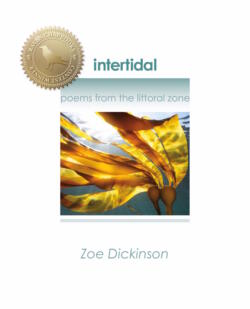 Most chapbooks are about twenty pages in length and this one is forty-five beautiful pages. The stunning cover photograph of baby Bull Kelp “growing towards the sun” is by Jackie Hildering, also known as The Marine Detective, an underwater photographer and biology teacher living on northeast Vancouver Island.
Most chapbooks are about twenty pages in length and this one is forty-five beautiful pages. The stunning cover photograph of baby Bull Kelp “growing towards the sun” is by Jackie Hildering, also known as The Marine Detective, an underwater photographer and biology teacher living on northeast Vancouver Island.
Pat Walker designed the book which is a gorgeous tribute to the poems and their subjects. The paper has a smooth finish which makes the book wonderfully tactile. The papers used are described and the main pages are Pacesetter 100# Silk text. (I know at least one person who is interested in paper!)
Illustrations throughout are in black and white as well in colour which add a whole other level of discovery. They’re by Ernst Haeckel (1834 – 1919) who was a German zoologist, naturalist, physician, marine biologist and artist. “He discovered, described, and named thousands of new species, mapping a genealogical tree relating all life forms and connecting many terms in biology.”
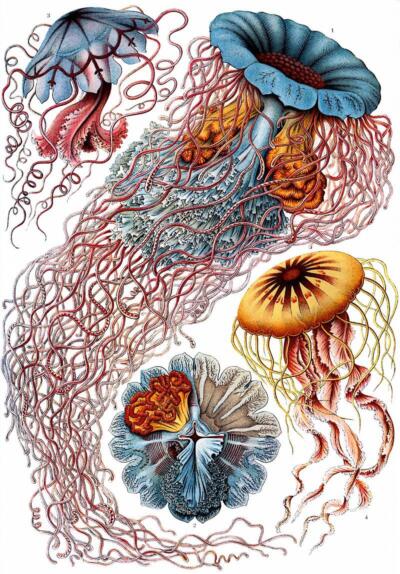 The poems have a beautiful intricacy as well as intimacy in their crafting with a simplicity that is profound in their descriptions of the complex ecology of the Pacific West Coast.
The poems have a beautiful intricacy as well as intimacy in their crafting with a simplicity that is profound in their descriptions of the complex ecology of the Pacific West Coast.
Zoe begins with “I’d like to start by acknowledging” in which she lists a series of acknowledgements of the place “this poem is being written” which is the unceded territories of the Lekwungen speaking peoples. She acknowledges that “my life takes place where someone else’s life should be happening.” She realizes the power of language and of poetry:
. . . if poetry is a way of learning to know the world
then I want my poems
to show this truth
not hide it
and if I’m honest
those are the only two choices.
This is a poet we can trust with her astute observations, knowledge, and a reciprocal relationship with what surrounds her.
The illustration is “Discomedusae” by Ernst Haeckel (1834 – 1919)
The poet mourns the collapse of starfish and receives advice from anemone. And it’s good advice: “share your flesh with someone / who can appreciate it –“
. . .
spit out what does not serve you–
no point in hanging on
to someone else’s shelf.
(“anemone advice”)
In the poem entitled “the meeting,” it’s exciting when the “orcas come” as the speaker thinks “my feet have touched – at low tide— / the place they are swimming . . . “ She acknowledges their connection.
I was fascinated by the name “nudibranch” when Sarah and I moved to Vancouver Island. Zoe has a “nudibranch” poem in which the speaker declares:
well, that’s one way to deal with fear:
instead of getting harder,
cast off the shell
become all soft underbelly
expose every bit of glowing skin
and dare the world to take a bite
what is armour
but participation
with the predator?
The speaker ends with “teach me to be soft / and inexorable.”
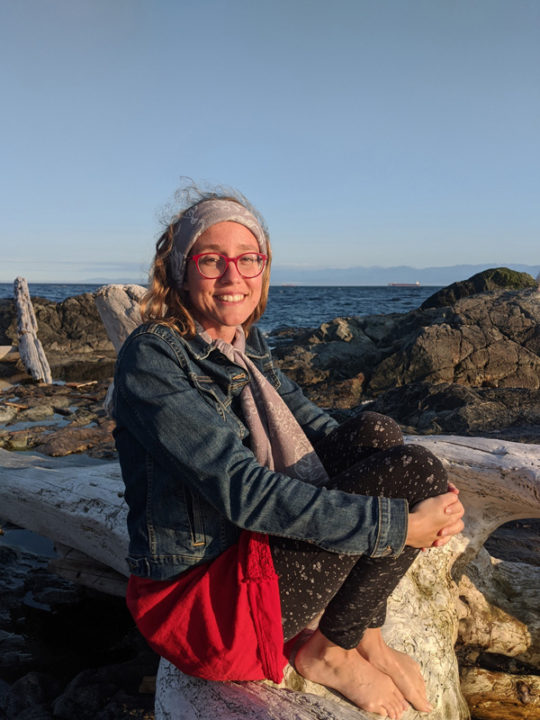 Zoe gives us hope for the human race not only due to her care about and for the shoreline of the Pacific Ocean on Canada’s West Coast. She offers a poem with that title: “hope for the human race” in which the irksome mosquito gets recognized. The narrator lets us know:
Zoe gives us hope for the human race not only due to her care about and for the shoreline of the Pacific Ocean on Canada’s West Coast. She offers a poem with that title: “hope for the human race” in which the irksome mosquito gets recognized. The narrator lets us know:
how the mosquito’s gaze carries messages
between flowers
after dark
how human blood
becomes a link in this ancient chain
and we
accidentally
nourish a constellation of blooms
is proof that even the worst pest
fulfills a purpose in the ecosystem
despite ourselves
Indeed hopeful, wouldn’t you say?
In the poem entitled “bryozoa” which are commonly known as moss animals living in sedentary colonies (thank you Wikipedia) the narrator reflects on her human self:
. . .
some animals discard shells —
bryozoans
discard bodies
keep the shell,
regrow from the outside in
as though
the space we inhabit
holds our true identity
as though all I’d need
to remake myself
is the indentation
my body leaves in the couch;
that crook
in your neck
where my cheek fits perfectly.
Simply exquisite. You’ll want to read the complete poems yourself and celebrate the poetry of Zoe Dickinson and her love of the “incredible diversity of life” on the rocky shores of Juan de Fuca strait.
Raven Chapbooks is an independent press on Salt Spring Island, British Columbia and an imprint of Rainbow Publishers. Diana Hayes is the publisher and she takes great care in creating beautifully designed chapbooks in small editions. That’s part of her mandate as well as “to support poets by providing a launching pad for wider audiences.”
You can order your own copy of intertidal: poems from the littoral zone, here: https://www.ravenchapbooks.ca/
by Mary Ann Moore | Jul 8, 2022 | A Poet's Nanaimo
Lori Fox, based in Whitehorse, Yukon, describes their new book of essays, This Has Always Been a War (Arsenal Pulp Press, 2021), as a “scrappy, angry little book” with its sub-title of “The Radicalization of a Working-Class Queer.”
In an interview with Yukon News for which she has been a writer, Lori said: “The book is incredibly vulnerable. I’m incredibly blunt, and really upfront with some very difficult things. And I pull no punches.”
Indeed, there is much to be angry about as Lori describes in their wonderfully written, often visceral, essays. The essays describe their confrontations “with the capitalist patriarchy through their experiences as a queer, non-binary, working-class farmhand, labourer, bartender, bushworker, and road dog . . .” As the book’s cover description says: “Capitalism has infiltrated every aspect of our personal, social, economic, and sexual lives.”
It is their work as a journalist that led me to Lori’s book as I’ve very much appreciated their opinion pieces in The Globe and Mail.
The dog on the cover, designed by Jazmin Welch, probably represents Herman who has been by Lori’s side through many hardships and adventures, at lean times sharing a meal of ramen noodles.
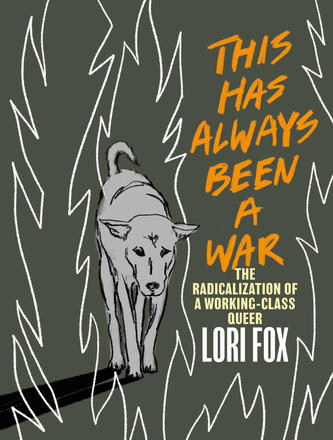 This Has Always Been a War is, Lori says, “for my people, the working classes, who cook the meals and pick the fruit, who serve the tables and stock the shelves, who work the gigs and deliver the orders. We are the makers and builders and doers of this world, and all that is in it belongs to us.”
This Has Always Been a War is, Lori says, “for my people, the working classes, who cook the meals and pick the fruit, who serve the tables and stock the shelves, who work the gigs and deliver the orders. We are the makers and builders and doers of this world, and all that is in it belongs to us.”
If you don’t already consider the wait staff in the restaurant you visit, or the people who have picked the fruit that you buy at your local grocery store or any number of people who “serve” us, you will have your eyes open to the indignities suffered, the abuse meted out by those in power, and the deplorable conditions people work under when you read this book. Lori Fox has experienced it all first hand.
Lori fights back in the very writing of this book and when they’re able, to physically retaliates. In “At Your Service,” the first essay in the book, Lori is working in an Ottawa pub where a male customer sexually assaults them. Lori upends a pitcher of sixty ounces of cold Molson Canadian over him. Good for you Lori Fox, I said to myself.
The customer who was escorted off the premises, called in the next day “to complain about the quality of service he’d received.” Thankfully, Lori had “hands down the best boss I’ve ever had,” who hung up on the “groper.”
Lori reflects: “As a consumer, he [the customer] felt entitled not only to my service, but to look at, even touch the body committed to that service, because my body (or, at the very least, my feminine attention) was viewed as part of what he’d paid for when he bought that pitcher of Canadian lager.”
From 2003 to 2020, Lori “was employed, more or less continuously in family diners, nightclubs, fine dining establishments, greasy spoons, blue-collar dives” and a whisky bar.
“Capitalism is not simply an economic system, capitalism is culture. Specifically, capitalism is our culture. And under capitalism – within our culture – working-class bodies are property,” Lori writes.
“Feeding people, giving people good food and good drink and a place to sit and talk and laugh, or a place to be alone and have someone take care of them so they can just enjoy and think, is a genuinely beautiful thing,” Lori writes. They note other beautiful things and says: “there are also people who work really, really hard and still don’t have enough to pay the rent and buy groceries.” There are people who can’t afford to take a day off to go to the doctor when they’re sick or go to the dentist because they can’t afford it.
Capitalism is “a system of learned helplessness,” Lori writes. “And it doesn’t have to be this way.”
In “The Happy Family Game,” Lori describes their home life which was a frightening place to be.
“The objective of the Happy Family Game is to create a nuclear family unit which, either in reality or in appearance, looks to outside eyes to be ‘successful in every way including’ doing their moral duty to purchase and enjoy the products and services that capitalism creates.”
When Lori, at twelve years of age, told their mother that their mother’s father had raped them, Lori was told not to tell anyone as if getting their grandfather in “trouble” and “tearing the family apart” would be their responsibility.
“In the Happy Family Game, men are the only players who matter,” Lori writes.
The silence for many who have suffered trauma is worse than the event or assault, in this case, itself. Lori says the event was not spoken of again and they were “made to continue behaving as if nothing had happened.” The family was protected at a child’s expense.
Growing up also meant living with a raging father who she writes about in “Every Little Act of Cruelty.” Lori describes living with him was “like living with a toddler – a 180-pound toddler in charge of the chequebook, with access to firearms.” Following his meltdowns or rages, “in other words, completely insane,” it was if they didn’t happen.
Lori writes: “as an adult and a transmasculine person, someone who occupies the vast and wild country in between man and woman, I am also terribly afraid of becoming him. Of becoming a man like him.” They have inherited physical similarities and other “less tangible traits.” Those intangible traits are: “A tendency toward depression. Chronic, near-crippling anxiety. Panic attacks. Dissociation. Suicidal ideation. Hypervigilance.”
Lori and their brother were kept away from other children, neither visiting them or having them over. Questions could “lead someone to discover the severity of my father’s illness – and his abusive behavior. All this secrecy and misery, all this abuse and suffering, and loneliness, was allowed to continue with one thought in mind: to protect my father, not from himself, which actually would have been useful, but from losing face in the eyes of the world.”
Lori, as a writer, a journalist, as someone who has lived experience as well as information gathered through their own investigative research, wonders why.
“Because my father was a straight white man in a straight white neighbourhood where you did not question the things straight white men did in their homes. A king in his castle. Capitalism needs patriarchy – specifically, it needs a family man headed by a patriarch.”
Lori shares “several truths” about their father including being “a deeply unwell man,” “an unhinged, unstable, misogynistic, violent prick who was a threat to himself and to others,” as well as a “family man who tried his best to provide for his family” and a man “disappointed that his life didn’t turn out the way he’d thought it would.”
I’ve read several memoirs and the horrible conditions people have grown up in makes me wonder how they ever made it to adulthood. One way of surviving as an adult, is to write about what happened, creating a bridge between then and now, putting an end to silence.
Sue William Silverman, author of Because I remember Terror, Father, I Remember You, said about her own memoir writing: “I could hold this book, this tangible thing. And it takes it out of you. It’s like writing that pressure out of the pressure cooker. Each word that comes out is like taking a little piece of pain with it and putting it on the page. Which isn’t to say that you don’t still have feeling about it. Of course you do. But it just takes away a lot of that power it has over you, and you feel a kind of distance towards it.” (from Writing Hard Stories: Celebrated Memoirists Who Shaped Art from Trauma by Melanie Brooks)
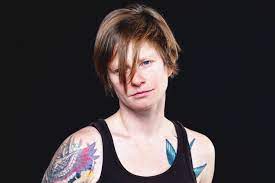 Lori writes about dystopian novels in their essay “Where the Fuck Are We in Your Dystopia?” Margaret Atwood’s The Handmaid’s Tale is included among the ten titles Lori read or primarily consumed as audiobooks, most of them written in the last five years. (They also read Atwood’s The Testaments.)
Lori writes about dystopian novels in their essay “Where the Fuck Are We in Your Dystopia?” Margaret Atwood’s The Handmaid’s Tale is included among the ten titles Lori read or primarily consumed as audiobooks, most of them written in the last five years. (They also read Atwood’s The Testaments.)
In one hundred hours of words, “queer people are almost entirely absent.” The works are described as “feminist dystopian fiction” and Lori asks: “For whom is the ‘feminism’ it depicts? How can you have feminism without queer women and non-binary people?” Which leads to the question raised in the title of the essay.
Also, “What is missing, largely, is people of colour and working-class people.”
Lori calls Atwood “a champagne feminist” at best and votes for “the more talented and good-hearted Alice Munro to usurp Atwood as Canada’s Literary Queen.”
The longest essay in the book is “Call You by Your Name” about a relationship Lori had with a man that was complicated, hurtful and as it turned out, abusive. Lori had quit her job and “disappeared into the bush with my truck and camper” after her lover Gabrielle left them.
In an earlier essay referring to the relationship with the man she calls Lucky, “The Hour You Are Most Alone,” (published previously in The Guardian), Lori writes:” I began a relationship with a man who quickly took what little control I had left. Charming and manipulative, he threatened and abused me physically and emotionally, assuming control of my money, curating where I went and who I spoke to. When I had the strength to protest, he battered me down.”
In “Call You By Your Name,” Lori addresses as “you.” I can’t help but see Lori’s situation with the manipulative man as a microcosm of their life in a “capitalist patriarchy.” Even when reaching out for some help to two men in business suits at Whistler, B.c. where Lori was living in her camper and working construction, offered nothing. Lori had been raped by her boyfriend and wondered if the men knew of any hotel rooms that weren’t too expensive. They suggested going home and one said: “ . . . my boyfriend was probably worried about me.”
This is the essay that is visceral and graphic in its descriptions of the abuse meted out and Lori’s physical reactions.
The essay that gives the book its title, “This Has Always Been a War,” is about Lori’s work at a vineyard in Naramata, B.C. where their job was “thinning.” There are several wineries in Naramata on Okanagan Lake “where the houses of the wealthy popped up all in a line on either side of the road, like fairy ring mushrooms.”
At the vineyard, workers “were not to use the indoor washrooms, which had running water, but the green porta johns . . . “. It was financially impossible for workers to live in the village. Earlier in the season, Lori had worked picking cherries for a farm where there was a bunkhouse. The workers who had camped in tents were gone and the farmer offered to let Lori stay on. The bunkhouse had a stove and a fridge but no bathroom. Workers used “porta johns” but they were gone as the workers were gone. Lori used a “President’s Choice Dark Roast coffee tin.”
While hired to do garden work to supplement their meager income, Lori was invited into the house only once by the wife “of a ridiculously wealthy older man who owned several wineries in the area” to use the washroom.
One day, when her employer and her guests were seated outside at a table drinking wine, she spoke to Lori. All kept their distance not offering Lori anything to drink in the heat. One of the women acknowledged it was difficult for workers to find a place to live. Lori said she lived in a tent on one of the farms and before that on a logging road in her truck.
“There needs to be a communal camp for all the workers, so we’d have running water and showers and a place to sleep and cook,” Lori said. Her employer waved her one hand “as if brushing the idea away.”
Lori’s employer said: “Where would we put it that it wouldn’t be in the way? It’s also far too expensive – and the government won’t give us any money for it. We can’t be expected to pay for it ourselves.” That sort of comment makes we want to spit!
As we eat cherries from the Okanagan and drink wine from the same area of B.C., let’s be aware of what it took to get those items to us.
When Lori was last working in Naramata in 2018, they “thought about how it was that a handful of people could have everything, while so many people did not have enough, or anything at all.” The workers in the fields, picking the fruit and cutting the vines, “grew food they didn’t get to eat and made wine they didn’t get to drink.”
There are several paragraphs beginning with “what if” including: “What if working-class people just stopped working?”
“To free ourselves from capitalism might mean violence, but that violence would be – is – self-defence.
“I’m not calling for war. This already a war.
“This has always been a war.”
by Mary Ann Moore | Jun 20, 2022 | A Poet's Nanaimo
Writing in community is something I’ve done for a long time – at workshops, retreats and in writing circles I’ve offered since 1997. Even during the pandemic, I facilitated weekly women’s writing circles via email and Zoom. It was a way for us to feel connected, part of a community, and grounded in the midst of it all.
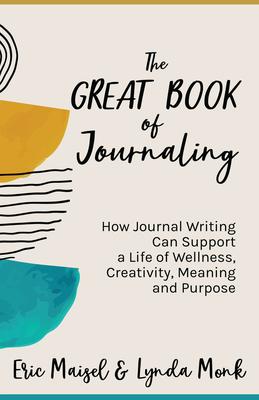 My contributing chapter to a new book that came out last week, The Great Book of Journaling, is “Journaling in Community.” Lynda Monk who is the director of the International Association for Journal Writing (IAJW) and Eric Maisel, author of fifty plus books, are co-editors of the collection. They’re both on the IAJW Journal council as am I.
My contributing chapter to a new book that came out last week, The Great Book of Journaling, is “Journaling in Community.” Lynda Monk who is the director of the International Association for Journal Writing (IAJW) and Eric Maisel, author of fifty plus books, are co-editors of the collection. They’re both on the IAJW Journal council as am I.
I’m very pleased to be among the contributors who have inspired my own writing and creativity for many years including SARK, Judy Reeves, Sheila Bender, Kathleen Adams and many others. And I feel especially blessed to have my work supported in the world by Lynda and Eric in the book as well as by Lynda through the IAJW.
As I say in “Journaling in Community,” a ceremony is key for the depth of experience whether on your own or in a circle. “Part of that ceremony is the creation of a container to acknowledge the people in the circle as well as the stories they are writing and giving breath to. It’s a way to create a sense of safety for the stories shared, lessen the anxiety, and honour the people and their stories.”
Here is a link to Mango, the publisher of The Great Book of Journaling. The book is distributed in Canada by Raincoast and you can ask for a copy at your favourite independent bookstore where it’s always fun to browse.
Now that there’s more ventilation indoors and we can meet outside if we choose, I’m looking forward to offering a Writing Life women’s writing circle this summer at our new location in the country. The theme is “All Our Relations.”
Every day Sarah and I walk the land and continue to appreciate spring unfolding with daffodils in the field and blossoms on the plum trees. We’re on five acres so I’m calling it a field rather than a yard. Now there are clumps of daisies in various places, two Golden Chain trees, a flowering dogwood and several varieties of roses.
 I made a flower essence from the Golden Chain tree at our last home. The definition is: In Praise of the Small. I always introduce a flower essence or flower essence combination to the writing circle to offer Nature’s support and insight. This one, Golden Chain Tree, Common Labaurnum, supports our own still centre in the midst of overwhelm and helps us appreciate the small in the midst of the magnificent. It encourages a sense of curiosity and wonder for the tiny creatures of the world, small things, and small moments. Here’s a link to more information about the Golden Chain Tree flower essence from Spirit of the Island.
I made a flower essence from the Golden Chain tree at our last home. The definition is: In Praise of the Small. I always introduce a flower essence or flower essence combination to the writing circle to offer Nature’s support and insight. This one, Golden Chain Tree, Common Labaurnum, supports our own still centre in the midst of overwhelm and helps us appreciate the small in the midst of the magnificent. It encourages a sense of curiosity and wonder for the tiny creatures of the world, small things, and small moments. Here’s a link to more information about the Golden Chain Tree flower essence from Spirit of the Island.
California lilac blooms in our front flower bed along with jasmine, cinquefoil purple irises and lots of lavender. We’re delighted to see rabbits and deer, an eagle occasionally, and although we saw a bear on two occasions, we haven’t seen it lately. I hope it is finding berries to eat as spring as been very reluctant this year.
The property is bordered by fir trees, arbutus and many wild flowers such as small-flowered lupine and bushes of Nootka roses with their beautiful scent.
At the summer writing circle (for four weeks beginning Wednesday, July 27th), we’ll take a walk around the property to connect to “all our relations” and come back to the house, whether inside or out, to write with gratitude, curiosity and possibly surprise. No previous writing experience is necessary to join the circle.
As noted above in the excerpt from “Journaling in Community,” we create a ceremony in the circle and we follow guidelines so as to create some structure in the space to help make it feel safe and welcoming. While you may not set out to write about grief and loss, uncomfortable memories may seep in when you take the time to be still and silent.
When you sit down to write, you may get the sense that your stories have been waiting for you. In the circle, there’s a particular alchemy that takes place when we gather with the intention of tapping into our stories from life and sharing them with witnesses and companions.
If you’d like to know more about the guidelines I follow in the women’s writing circles, you will find them on the same page as the Writing Life Circle info (Wednesday, July 27 to Wednesday, August, 10: 30 a.m. to 1 p.m.) here.
by Mary Ann Moore | Jun 11, 2022 | A Poet's Nanaimo
If You are Reading This is Sheila Norgate’s a/mem.oir/ish, a book of personal essays published under her own imprint: LIP (Ladies Institute Press).
As Sheila told me in a phone conversation, she’s a “one girl band” having written the book, designed it (including the amazing cover) and published it. I’ve always thought writing to be one of the healing arts and taking one’s story and putting it into the world is all part of that healing. Sheila agrees, that it’s especially important for women to put our words into the world.
Readers will have their own endings to “If You Are Reading This” which could be similar to my responses: “be forewarned;” “be prepared to laugh;” “expect to be shocked and amazed,” and “you’ll have your socks knocked off.”
Sheila’s memoir includes all that a feminist memoir ought to. She lets us know what happened in her life, how she felt about it and she has observed and researched the bigger picture that has affected her and in fact, all women.
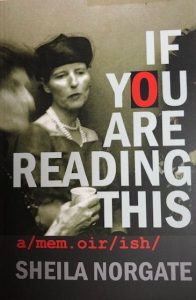 If You Are Reading This reads on the page as Sheila sounds in her performances, sharing her stories from life with humour and gravitas. She has given one-woman performances for many years, doing the writing, producing and presenting to enthusiastic audiences. I’m grateful I was able to attend several of them on Gabriola Island, B.C. where she lives with her partner Debbie, as well as in Victoria and Nanaimo.
If You Are Reading This reads on the page as Sheila sounds in her performances, sharing her stories from life with humour and gravitas. She has given one-woman performances for many years, doing the writing, producing and presenting to enthusiastic audiences. I’m grateful I was able to attend several of them on Gabriola Island, B.C. where she lives with her partner Debbie, as well as in Victoria and Nanaimo.
Sheila told me she wouldn’t be performing if she hadn’t moved to Gabriola in 1999. Besides Gabriolans being a fabulous audience, publicizing an event and renting a hall is much more inexpensive than it would be in Toronto or Vancouver.
Sheila has also done much research into issues concerning women including the “advice” we’ve been given through the years. That advice is entertaining as well as horrifying. Sheila has a collection of etiquette books published between 1930 and 1960 that have provided her with evidence that women have been continually told how to “slim, trim, pin down, curb [and] limit.”
Also a visual artist, Sheila says in the introduction to her book that her memoir was “stowed away for 30 years in my visual art practice.” The memoir “started to bleed out” into her paintings to which she gave titles in the early years (1980s). Text made its way onto the canvas in the form of penciled handwriting and later with alphabet stamps. So they would be large enough, Sheila carved her own stamps out of rubber.
While Sheila may have lost patrons due to the “predilection,” for words, she figures that’s none of her business. “The business of any artist is to take direction from her muses, not her shifting fanbase.”
One of her essays, “On Being a Lady Painter,” describes Sheila’s journey as a visual artist with illustrations of her work.
It takes courage, and some outrageousness, to stand up and tell one’s life story to an audience. The challenge for Sheila was committing her memoir to “hardcopy.” She figures performances are more “transitory” whereas writing can be referred to again.
She’s done it, taken on the printed page, and her wings are now spread wide to include performance, visual art and published writing.
In “Lesbian Nightowls & Other Oxymorons,” Sheila says lesbians “can’t seem to remain conscious past 9:30 p.m.” As for “lesbian bed death,” a phrase coined by a sociologist in 1983, Sheila has done some investigating. Two women may have less sex than other couples (straight or gay men) because there is the likelihood one or both have experienced sexual violence. (One in four women in Canada have or will experience sexual violence.)
Sheila notes internalized homophobia too for “no matter how liberal and inclusive” people are, it falls “to us (the queer folks) to deal with our internationalized homophobia.”
I’m thinking lesbians have more in common with one another than with male partners and they may have expended most of their energy on those shared passions until 9:30 p.m. You can see there is much to discuss at the next lesbian potluck.
When writing about “The (Not So) Great Out-Doors,” Sheila thinks “there’s always a predator out there. It isn’t lost on me that the predators from my childhood were in fact, my parents, and they operated almost exclusively indoors.”
And yet Sheila felt she had more control indoors “simply because the jurisdiction of my worry is so much smaller when compared with the outdoors.”
Sheila’s “early holding environment” was not even close to “good enough” and if it was for you, says: “It won’t likely occur to you to take up psychotherapy on a permanent basis, or routinely daydream about suicide, or swap out intimate relationships like snow tires, or volunteer for a phone-in crisis line only to have to make your own desperate late-night call a few months later. These are all things I have done.”
Before she could form full sentences, Sheila would have to answer Einstein’s question about whether the world is a friendly place with the word “no.”
Her beloved small maltese-poodle named Rosie adopted in 2001 gave Sheila unconditional love that lasted seventeen years. Among the paintings of dogs Sheila did, one of her favourites was “first responder.” Rosie offered Sheila “the power of secure, uncontaminated love,” cheering her on.
 In an essay entitled “Always Becoming Never Quite There,” Sheila describes the collection of etiquette books I mentioned earlier. She has 127 of them that include “charm manuals, beauty guides, sewing handouts, and home economics texts.”
In an essay entitled “Always Becoming Never Quite There,” Sheila describes the collection of etiquette books I mentioned earlier. She has 127 of them that include “charm manuals, beauty guides, sewing handouts, and home economics texts.”
Sheila wasn’t “particularly shocked to read that it’s not good form for a woman to stop at a motel without luggage.” What she “wasn’t prepared to exhume, was the cover-to-cover counsel littering these books about how to “control, contain, restrain” and many other words to that effect to “generally correct the female body.”
Sheila writes: “And we might just want to ask who benefits from the campaign to divert women and girls from the real work of our lives; to be fully embodied, to be fully engaged, to be steeped in our voices.”
A beautiful manifesto for women, I think.
“MelancholyBaby” begins with humour: “On the night I was born, my mother was at home, and my father – an amateur spiritualist – was at a seance.”
Uncle Paul, with his 1946 Buick sedan, was contacted by Sheila’s mother who was at home and going into labour. He “retrieved” Dad from the seance and they headed for the hospital. It was February 7, 1950 and “somewhere near the busy intersection of Queen Street and Broadview Avenue in Toronto” Sheila’s mother, in the back seat with Dad, “succumbed to the physiological imperative.”
Sheila describes what a birth in the hospital would have been like for women in 1950 flat on their backs, sedated against their will and other horrors.
Sheila and her mother didn’t make it to the hospital for the birth and they were separated when they got there. They didn’t see one other for several days.
“Some 30 years later, my mother admitted that she hadn’t been able to bond with me. It was shortly after this conversation, that I engaged the first in a long, protracted motorcade of therapists.”
Sheila writes of having rosacea and Raynaud’s disease which causes fingers and toes to go white and numb. In a chapter titled “Little Pigs Have Long Ears,” she describes having otoplasty at the age of eight which “refers to a genus of plastic surgery procedures designed to correct anomalies of the external ear.”
Sheila’s ears still hurt if she lies on either of them for an extended period of time. The one thing that saw her through the time in the hospital following surgery (her mother’s decision), was the fact she made the nurses laugh.
As with other memoirs in which women tell their stories from life, Sheila writes of what happened in her early life and how it affected her and shaped her. She’s been a “seeker” all her life she told me and has read extensively, especially books about how to be “less fucked up.”
The main thrust of that seeking, she said, has been to see what makes her tick and how to manage in this world.
Much of Sheila’s learning was done through psychotherapy as she went into therapy in 1981. She remembers back to the time she took two years of a general arts degree at the University of Toronto and “psych” or “soc” were part of the title of every course she took.
Sheila writes of her parents, her mother, an English “war bride” from England and her father, a Canadian serviceman, in “Pier 21” where her mother would have entered Canada via Halifax.
“In Seriously Funny Girl,” Sheila writes of being funny all her life. While still in school, as she reflects in her essay on the humour related to her slow developing breasts, she writes: “Back then, I was unaware of the role that self-effacement played in my life, but I see now that it was a pre-emptive strike of sorts. A comedic confessional where nobody could get anything on me that I hadn’t already gotten on myself.”
 The chapter entitled “God and I Are Like This” took the longest to write she told me. It’s the final chapter in which there is so much to which I can relate: going to Sunday School, finding “second-wave feminism in the back room of the Toronto Women’s Bookstore” and having Alister Crowley tarots cards among her belongings. Sheila writes of finding love, losing it for a time, and finding it again.
The chapter entitled “God and I Are Like This” took the longest to write she told me. It’s the final chapter in which there is so much to which I can relate: going to Sunday School, finding “second-wave feminism in the back room of the Toronto Women’s Bookstore” and having Alister Crowley tarots cards among her belongings. Sheila writes of finding love, losing it for a time, and finding it again.
There’s lots more to Sheila’s story that you’ll have to read for yourself including her powerful and poignant last sentence which has come after much investigation, reflection and self-compassion. Although there’s a sense of happily ever after, there is also the fact that there is much in the world to rant about. I expect Sheila will be doing more of that.
To order a copy of If You Are Reading This, visit Sheila’s website where you can hear her read small portions from her book.
If you are in Nanaimo or surrounding area, Sheila will be reading from If You Are Reading This at the downtown Nanaimo branch of the Vancouver Island Regional Library on Saturday, June 25th from 2:30 to 3:30 p.m. See further info here.
by Mary Ann Moore | May 30, 2022 | A Poet's Nanaimo
I’m a fan of mysteries particularly detective fiction by the likes of Elizabeth George, Peter Robinson, Val McDermid, Michael Connelly, Jonathan Kellerman, David Baldacci, Louise Penny, Kate Atkinson and so many more going back to P. D. James and Agatha Christie.
Death at the Savoy is rather like an Agatha Christie novel as its “plucky” protagonist , Priscilla (never Prissy) Tempest is the accidental sleuth, as well, in this case, a suspect , finding herself, quite often, in the wrong place at the wrong time.
I enjoyed Death at the Savoy not so much for a chasing of clues to find a killer but because I appreciated its lightness while wondering who among the rich, famous and aristocratic would turn up next at the Savoy. I’m thinking Ron Base and Prudence Emery would have had great fun cooking up this mystery.
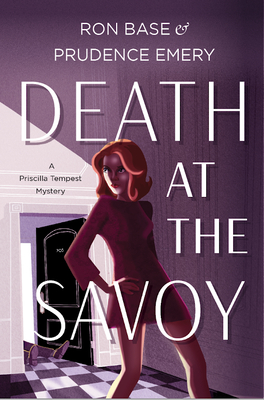 Death at the Savoy: A Priscilla Tempest Mystery (Douglas & McIntyre, 2022) by Ron Base and Prudence Emery is the first in a mystery series. Ron Base is a former newspaper and magazine journalist who has written twenty novels. He divides his time between Milton, Ontario and Fort Myers, Florida. Prudence Emery is the author of Nanaimo Girl (Cormorant Books, 2020) who worked as the press and public relations officer at the Savoy Hotel in London, England from 1968 to 1973. Pru was born in Nanaimo and now lives in Victoria, B.C.
Death at the Savoy: A Priscilla Tempest Mystery (Douglas & McIntyre, 2022) by Ron Base and Prudence Emery is the first in a mystery series. Ron Base is a former newspaper and magazine journalist who has written twenty novels. He divides his time between Milton, Ontario and Fort Myers, Florida. Prudence Emery is the author of Nanaimo Girl (Cormorant Books, 2020) who worked as the press and public relations officer at the Savoy Hotel in London, England from 1968 to 1973. Pru was born in Nanaimo and now lives in Victoria, B.C.
The years spent working at the Savoy Hotel are described by Prudence as “the champagne-filled years” which is also the case for the young heroine of Death at the Savoy: Priscilla Tempest. Priscilla, a Canadian, works at the Savoy Press Office, Room 205, or simply, 205. Her assistant is Susie Gore-Langton whose aristocratic family’s luck “had more or less run out.”
The Savoy sounds grand in reality as well as in the fictional version created by Ron and Prudence. At the fictional hotel, in 1968 with London “in full swing,” there are two murders; a Scotland Yard Inspector, Robert “Charger” Lightfoot, called in to investigate; a general manager, Clive Banville; and other hotel employees who may not be all that they pretend to be, and there are those famous guests.
As it’s 1968, women visiting any of the Savoy restaurants aren’t to wear trousers. Katharine Hepburn was turned away for lunch at Claridges, “one of the Savoy Group’s restaurants, because – horrors! – she was wearing her trademark trousers.”
Prudence relied on her own recollections as well as friends who had also worked at the Savoy such as Susie Grandfield who “covered” for Pru when she was press and public relations officer there.
The chapter describing the guests is wonderfully gossipy. “Elaine Stritch might show up unexpectedly.” Bob Hope is expected and Louis Armstrong and Tony Bennett would soon be back. “The Queen Mother was due for a luncheon.”
Princess Margaret figures into the mystery with the hope by the authors “that we can be forgiven for the occasional misbehaving princess . . . “
As the book opens, Priscilla has a headache from drinking champagne at the Covent Garden opening of Luciano Pavarotti’s “starring turn in Verdi’s Rigoletto.” She has attended the opera with Amir Abrahim who had been “far too frisky” and is now dead in 705.
Priscilla’s job is to keep anything that may negatively affect the reputation of the Savoy away from the press. Percy Hoskins, a reporter from the Evening Standard, gives her a call, has heard of the murder and wants to know more. The character of Percy Hoskins is “a quiet salute to an old friend, long gone.” There really was a Percy Hoskins “back in the day as Fleet Street’s ace crime reporter.”
That’s what I enjoyed the most about the book: its links to the Savoy’s history.
Noel Coward visits Priscilla at 205; he’s just back from Jamaica and wants to share a Buck’s Fizz. (Noel Coward, knighted in 1970, “the grand old man of British drama,” died in 1973 at his home in Jamaica.)
Buck’s Fizz does sound delightful from what I read on Wikipedia. It’s an alcoholic cocktail made up of sparkling wine, typically champagne, and orange juice. It’s similar to a Mimosa except Buck’s Fizz has two parts sparkling wine and one part orange juice. It’s those two parts that causes Priscilla to have some rough mornings.
As she returns home to her apartment owned by the Savoy after having two Buck’s Fizzes with Noel Coward, Priscilla meets a man outside her building who is having trouble with his MGB two-seater roadster that is overheated. Will Mark Ryde be a love interest or a man to be especially wary of?
Besides being pursued because she may know too much, Priscilla also finds herself in frightening situations through no fault of her own. When checking Bob Hope’s suite for him and given the wrong key, she is grabbed by a naked man who collapses, nearly dead, to the floor. It turns out the man is Bernard Bannister, a Tory member of parliament.
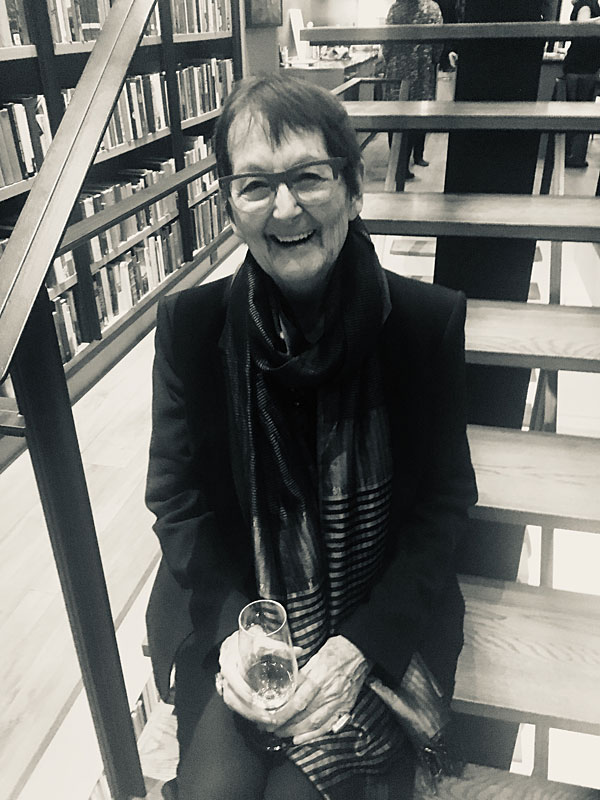
Photo: Prudence Emery
To lighten things up, Elizabeth Taylor and Richard Burton arrive and along with Noel Coward, Priscilla joins the celebrities for more Buck’s Fizzes.
With so much going on to keep under wraps, Priscilla is also assigned to take care of her boss’s, Mr Banville’s, mother-in-law Eunice Kerry. Eunice’s daughter Daisee is friends with Princess Margaret.
Priscilla agrees to work with Perry as she wants to clear her name due to being linked to Amir, the Egyptian arms dealer who was murdered as well as the Tory MP. More characters turn up and another dead person, this time a woman in Priscilla’s flat. You can see why she’d be a suspect in that case! References are made to “a secretive group of agents dubbed “the Walsinghams” who are “dedicated to keeping the royal family safe.”
Whether such a group exists or not, it’s such an apt name as (back to Wikipedia), Sir Francis Walsingham (c 1532 – 1590) was principal secretary to Queen Elizabeth 1 of England “and is popularly remembered as her ‘spymaster’.”
Priscilla gets roughed up by one of the bad guys, is kissed by a couple of suitors, gets to keep her job although “the management at the Savoy continues to cast a suspect eye as far as she is concerned.”
“Also, perhaps not surprisingly, Miss Tempest’s love life remains the subject of gossip and raised eyebrows.”
Prudence Emery and Ron Base are at work (and play, I imagine) at the next Priscilla Tempest Mystery: Scandal at the Savoy.
In writing about crime fiction in The Globe and Mail, Saturday, May 28, 2022 (oh yes, Daphne du Maurier and Patricia Highsmith!), David Moscrop says: “It satisfies multiple longings, from the mundane need to pass the time to the deeper necessity of self-exploration, including ventures into the darker corners of humanity. Through building and releasing tension, it provides us a chance to get in a form of mental cardiovascular exercise and some escapism, too. In the coming years, the need for each isn’t going to diminish and, indeed, is sure to grow.”
Much is said there about my reason for staying up late reading crime fiction. I loved Nancy Drew and Miss Marple and now I can have adventures with Priscilla Tempest – as well as, in her case, some much needed levity.
by Mary Ann Moore | May 23, 2022 | A Poet's Nanaimo
Nancy Slonim Aronie is the founder of the Chilmark Writing Workshop on Martha’s Vineyard, Massachusetts where she lives. She’s been facilitating Writing from the Heart workshops for forty-five years at various venues such as Kripalu, Omega and Esalen. In her new book, Memoir as Medicine: The Healing Power of Writing Your Messy, Imperfect, Unruly (but Gorgeously Yours) Life Story, she shares her good advice about writing, essays she has written for various publications, and excerpts from a previously unpublished memoir about her son Dan.
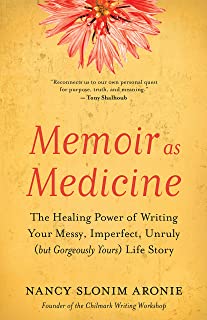 In an interview with her publisher, New World Library, Nancy said: “Getting your rage on the page and getting to the truth of what shaped you instead of having those stories marinating in your body, that’s the medicine.” As for the benefits of telling your story, Nancy said: “Telling your story and getting it out of your body is the beginning of healing. You will get a new perspective, maybe new insights, a new way of seeing the whole picture instead of just that tiny thing that happened or even a big thing that happened.”
In an interview with her publisher, New World Library, Nancy said: “Getting your rage on the page and getting to the truth of what shaped you instead of having those stories marinating in your body, that’s the medicine.” As for the benefits of telling your story, Nancy said: “Telling your story and getting it out of your body is the beginning of healing. You will get a new perspective, maybe new insights, a new way of seeing the whole picture instead of just that tiny thing that happened or even a big thing that happened.”
When asked about a spiritual component to memoir, Nancy said: “Spiritually, if you are willing to take the lessons from the information you’re accessing, because all you want to do is grow and be a more loving being on the planet, then of course there is a spiritual element.”
I appreciate what Nancy says about writing groups for writers: “Everyone needs a support system.” She recommends, as I do, that people don’t “criticize and destroy your voice.” Nancy said: “They can give you good advice, but to me, the most important part of that equation is that they find beauty in your work first.”
Where to start? Nancy said in her interview: “There are lots of beginnings. Chronology isn’t majorly important. Authenticity is. Storytelling is. Sounding like you, is. Connecting the dots, not only what happened but how it affected you, how it changed you, how it shaped you. Those are important. Not necessarily starting from when I was born and this happened and that happened and this happened.”
In an early chapter in the book, “You Don’t Have to Start at the Beginning of Your Life,” Nancy includes a few of her rejected beginnings and then the one she chose for a piece called “Rent-a-Mouth” previously published in Vineyard Gazette.
Nancy points out right at the beginning of Memoir as Medicine, that her one rule in her workshops is that when someone finishes reading, “tell her what you loved.”
This the approach, as referred to in her interview, I so appreciate. “When you are willing to take the chance of saying this is who I am, these are the things that shaped me, this is where I am now, magic happens, health happens, healing happens.”
“Say yes,” Nancy urges regarding the telling of your ongoing story. “Don’t worry about the ancestors. They’re dead. Don’t worry about the young ones. They can’t read yet. Don’t worry about your readers. You tell your truth, and they will turn the page.”
As poet Sean Thomas Dougherty says in answer to “Why bother?”: “Because right now there is someone out there with a wound in the exact shape of your words.”
As for the excerpts from her previously unpublished memoir about her son Dan, Nancy says: “Writing about my experiences with this sick kid gave me exactly what I needed to see what I was doing. It didn’t happen overnight. It was a long trip from brutal awareness to actual change.”
Dan was diagnosed with diabetes at nine months old and at twenty-two, with multiple sclerosis. For sixteen years, Nancy and her husband took care of Dan until he died at age thirty-eight. What she realized in writing her memoir about him was that by trying to make life “easier” for him, “by reinforcing the message that he was handicapped in every way, I was actually crippling him more than the disease was.”
Each of the chapters ends with a writing prompt such as “Write your book jacket.” This is a good way to figure out what the book you say you are writing is actually about. In Nancy’s example, about her proposed book, says: “The things she tells participants in her renowned writing workshops, ‘Write the sorrow out of your body or the sorrow will find its way into you’ and ‘You cannot skip the pain part,’ become the very things Aronie needs to learn for herself.” [Photo of Nancy Slonim Aronie by Eli Dag.]
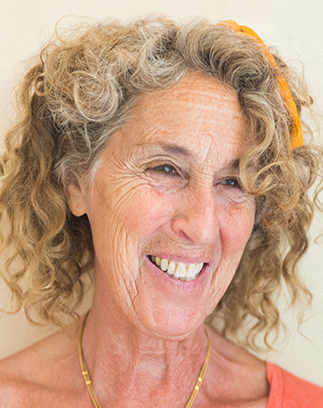 Besides being so honest in her memoir, Nancy shares her good humour. In the sample book jacket, she says of herself: “A control freak by nature. . . “
Besides being so honest in her memoir, Nancy shares her good humour. In the sample book jacket, she says of herself: “A control freak by nature. . . “
Later, when describing meeting her husband Joel in 1965, Nancy tells how her grandmother also fell in love with him. Gram would get Joel to fix the disposal in her sink and afterwards, in her Yiddish accent, say: “I hef two voids for dat boy: vunduh ful.”
As well as the humour, Nancy shares poignant pieces written about the days leading up to her sister’s death for instance. “Sisters” was previously published in Martha’s Vineyard Times and of the essay she says: “It was only by writing it that I was able to get in touch with what I really felt.”
“Don’t Shy Away from Taboo Topics” is one of the chapter titles and in this one, Nancy includes a piece about her son Dan’s constipation and how she helps out. In an earlier chapter, she receives a phone call from Dan about his impotence. Yes, Nancy took on the challenge of taboo topics.
Memoir as Medicine has chapters on Solitude, Grief, giving a story time to breathe, being an eavesdropper, using dialogue and “Read, Read, Read.”
As for Nancy’s stories about publishing her work, there are those too. I especially like the one about her experience working as an editor for Lear’s magazine and being fired by Frances Lear. She didn’t think she could write about the experience right away but an editor, Lary Bloom at Northeast Magazine, told her to write immediately. She later “realized how powerful it is to write when you’re in the middle of a tragedy.”
The piece was published in Northeast Magazine and is included in the chapter entitled “Write the Blood on the Page.” “Queen Lear” is a beautiful essay, full of dialogue, enthusiasm and Nancy’s good humour. She used what she calls the “Day 1, Day 2 . . . method” which got her started.
A good idea suggested by Nancy is serializing your memoir in a blog. In that particular chapter, Nancy says: “Write three titles for your blog.” There are real benefits to blogging as it keeps you writing, without outside pressure, and you have readers some of whom may even give you some positive comments to keep you going. You develop a writing community this way, maybe a following, and it could be “you might even catch the attention of a publisher so that the blog can turn into the book.”
Another good idea I’m realizing is that previously published pieces could be part of your memoir as Nancy has done. You could even include letters to the editor – if they tie into the theme of your memoir.
If you think you can “Just take all my journal entries and turn them in to a book,” Nancy says: “Good try, lazy bones.” With a journal, you’re usually writing about what happened. In a narrative, “you’re writing about what you learned from what happened.”
In a chapter near the end of Memoir as Medicine, Nancy advises choosing the best stories and omitting the ones that illustrate the same point. “We don’t need to hear how much you suffered. We need to know how much you survived.”
Nancy includes a poignant essay about her son Dan’s final days. Her final chapter, “Endings,” gives the advice she has followed herself: “You are not copying your journal entries. You are telling your story, showing your struggle, sharing your little victories and how you emerged out of the hole, only to be knocked back again, letting us climb out again and again with you. And ultimately giving us a map showing how you managed.”
There are many more examples to share with you but I think I’ll just suggest you buy the book and be inspired to find the medicine in the writing of your own stories.
 Most chapbooks are about twenty pages in length and this one is forty-five beautiful pages. The stunning cover photograph of baby Bull Kelp “growing towards the sun” is by Jackie Hildering, also known as The Marine Detective, an underwater photographer and biology teacher living on northeast Vancouver Island.
Most chapbooks are about twenty pages in length and this one is forty-five beautiful pages. The stunning cover photograph of baby Bull Kelp “growing towards the sun” is by Jackie Hildering, also known as The Marine Detective, an underwater photographer and biology teacher living on northeast Vancouver Island. The poems have a beautiful intricacy as well as intimacy in their crafting with a simplicity that is profound in their descriptions of the complex ecology of the Pacific West Coast.
The poems have a beautiful intricacy as well as intimacy in their crafting with a simplicity that is profound in their descriptions of the complex ecology of the Pacific West Coast. Zoe gives us hope for the human race not only due to her care about and for the shoreline of the Pacific Ocean on Canada’s West Coast. She offers a poem with that title: “hope for the human race” in which the irksome mosquito gets recognized. The narrator lets us know:
Zoe gives us hope for the human race not only due to her care about and for the shoreline of the Pacific Ocean on Canada’s West Coast. She offers a poem with that title: “hope for the human race” in which the irksome mosquito gets recognized. The narrator lets us know:
 This Has Always Been a War is, Lori says, “for my people, the working classes, who cook the meals and pick the fruit, who serve the tables and stock the shelves, who work the gigs and deliver the orders. We are the makers and builders and doers of this world, and all that is in it belongs to us.”
This Has Always Been a War is, Lori says, “for my people, the working classes, who cook the meals and pick the fruit, who serve the tables and stock the shelves, who work the gigs and deliver the orders. We are the makers and builders and doers of this world, and all that is in it belongs to us.” Lori writes about dystopian novels in their essay “Where the Fuck Are We in Your Dystopia?” Margaret Atwood’s The Handmaid’s Tale is included among the ten titles Lori read or primarily consumed as audiobooks, most of them written in the last five years. (They also read Atwood’s The Testaments.)
Lori writes about dystopian novels in their essay “Where the Fuck Are We in Your Dystopia?” Margaret Atwood’s The Handmaid’s Tale is included among the ten titles Lori read or primarily consumed as audiobooks, most of them written in the last five years. (They also read Atwood’s The Testaments.) My contributing chapter to a new book that came out last week, The Great Book of Journaling, is “Journaling in Community.” Lynda Monk who is the director of the
My contributing chapter to a new book that came out last week, The Great Book of Journaling, is “Journaling in Community.” Lynda Monk who is the director of the  I made a flower essence from the Golden Chain tree at our last home. The definition is: In Praise of the Small. I always introduce a flower essence or flower essence combination to the writing circle to offer Nature’s support and insight. This one, Golden Chain Tree, Common Labaurnum, supports our own still centre in the midst of overwhelm and helps us appreciate the small in the midst of the magnificent. It encourages a sense of curiosity and wonder for the tiny creatures of the world, small things, and small moments.
I made a flower essence from the Golden Chain tree at our last home. The definition is: In Praise of the Small. I always introduce a flower essence or flower essence combination to the writing circle to offer Nature’s support and insight. This one, Golden Chain Tree, Common Labaurnum, supports our own still centre in the midst of overwhelm and helps us appreciate the small in the midst of the magnificent. It encourages a sense of curiosity and wonder for the tiny creatures of the world, small things, and small moments.  If You Are Reading This reads on the page as Sheila sounds in her performances, sharing her stories from life with humour and gravitas. She has given one-woman performances for many years, doing the writing, producing and presenting to enthusiastic audiences. I’m grateful I was able to attend several of them on Gabriola Island, B.C. where she lives with her partner Debbie, as well as in Victoria and Nanaimo.
If You Are Reading This reads on the page as Sheila sounds in her performances, sharing her stories from life with humour and gravitas. She has given one-woman performances for many years, doing the writing, producing and presenting to enthusiastic audiences. I’m grateful I was able to attend several of them on Gabriola Island, B.C. where she lives with her partner Debbie, as well as in Victoria and Nanaimo. In an essay entitled “Always Becoming Never Quite There,” Sheila describes the collection of etiquette books I mentioned earlier. She has 127 of them that include “charm manuals, beauty guides, sewing handouts, and home economics texts.”
In an essay entitled “Always Becoming Never Quite There,” Sheila describes the collection of etiquette books I mentioned earlier. She has 127 of them that include “charm manuals, beauty guides, sewing handouts, and home economics texts.” The chapter entitled “God and I Are Like This” took the longest to write she told me. It’s the final chapter in which there is so much to which I can relate: going to Sunday School, finding “second-wave feminism in the back room of the Toronto Women’s Bookstore” and having Alister Crowley tarots cards among her belongings. Sheila writes of finding love, losing it for a time, and finding it again.
The chapter entitled “God and I Are Like This” took the longest to write she told me. It’s the final chapter in which there is so much to which I can relate: going to Sunday School, finding “second-wave feminism in the back room of the Toronto Women’s Bookstore” and having Alister Crowley tarots cards among her belongings. Sheila writes of finding love, losing it for a time, and finding it again. Death at the Savoy: A Priscilla Tempest Mystery (Douglas & McIntyre, 2022) by Ron Base and Prudence Emery is the first in a mystery series. Ron Base is a former newspaper and magazine journalist who has written twenty novels. He divides his time between Milton, Ontario and Fort Myers, Florida. Prudence Emery is the author of Nanaimo Girl (Cormorant Books, 2020) who worked as the press and public relations officer at the Savoy Hotel in London, England from 1968 to 1973. Pru was born in Nanaimo and now lives in Victoria, B.C.
Death at the Savoy: A Priscilla Tempest Mystery (Douglas & McIntyre, 2022) by Ron Base and Prudence Emery is the first in a mystery series. Ron Base is a former newspaper and magazine journalist who has written twenty novels. He divides his time between Milton, Ontario and Fort Myers, Florida. Prudence Emery is the author of Nanaimo Girl (Cormorant Books, 2020) who worked as the press and public relations officer at the Savoy Hotel in London, England from 1968 to 1973. Pru was born in Nanaimo and now lives in Victoria, B.C.
 In an interview with her publisher, New World Library, Nancy said: “Getting your rage on the page and getting to the truth of what shaped you instead of having those stories marinating in your body, that’s the medicine.” As for the benefits of telling your story, Nancy said: “Telling your story and getting it out of your body is the beginning of healing. You will get a new perspective, maybe new insights, a new way of seeing the whole picture instead of just that tiny thing that happened or even a big thing that happened.”
In an interview with her publisher, New World Library, Nancy said: “Getting your rage on the page and getting to the truth of what shaped you instead of having those stories marinating in your body, that’s the medicine.” As for the benefits of telling your story, Nancy said: “Telling your story and getting it out of your body is the beginning of healing. You will get a new perspective, maybe new insights, a new way of seeing the whole picture instead of just that tiny thing that happened or even a big thing that happened.” Besides being so honest in her memoir, Nancy shares her good humour. In the sample book jacket, she says of herself: “A control freak by nature. . . “
Besides being so honest in her memoir, Nancy shares her good humour. In the sample book jacket, she says of herself: “A control freak by nature. . . “